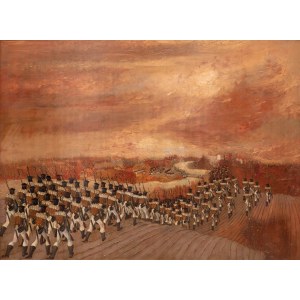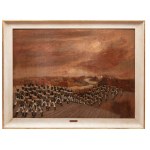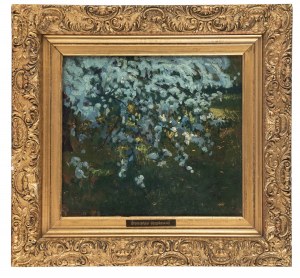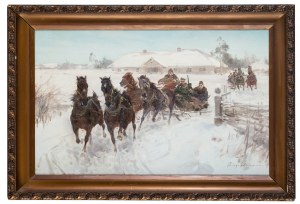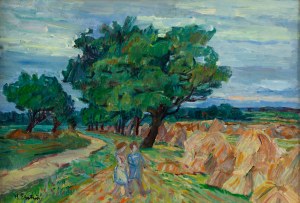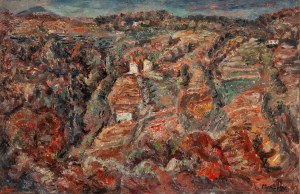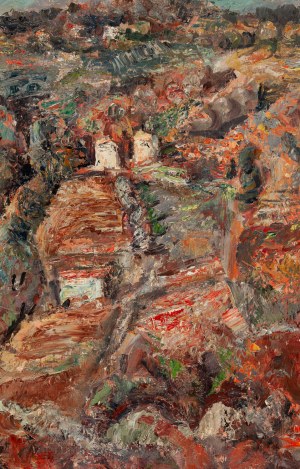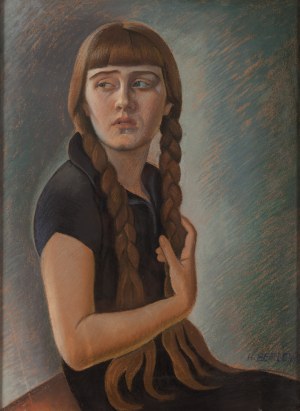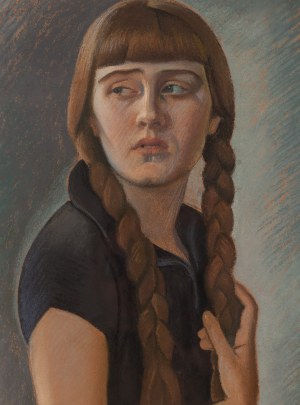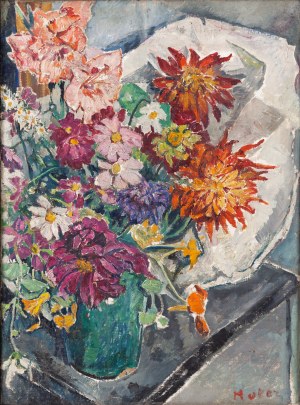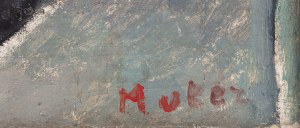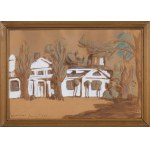oil, plywood, 91.5 x 121.5 cm
on the back stickers:
1) exhibition stamp - "CITY OF MANCHESTER/ ART GALLERY/878"; 2) exhibition stamp with description of work and number 49 - "Collection arranged by/THE ART EXHIBITION BUREAU/ 3-5 BURLINGTON GARDENS, LONDON"; 3) from framing firm "James Bourlet & Sons, Ltd." with number "B53729" and stamps (illegible)
Provenance:
- Collection of the artist's family, Poland
Exhibited:
- "Polish Art," The Art Exhibition Bureau, London
- Art Gallery, City of Manchester
- "Painters from the circle of Tadeusz Pruszkowski. Brotherhood of St. Luke - Warsaw School
- Freemasonry Lodge - Fourth Group", September - October 1978, National Museum in Warsaw.
Reproduced:
- Catalog of the exhibition "Painters from the circle of Tadeusz Pruszkowski. Brotherhood of St. Luke - Warsaw School - Free-Malar Lodge - Fourth Group", September - October 1978, National Museum in Warsaw, il. 46
- I. Kossowska, "Artistic Reconquista. Art in Interwar Poland and Europe", 2017, il. 568
Mentioned and described:
- Catalog of the exhibition "Painters from the circle of Tadeusz Pruszkowski. Brotherhood of St. Luke - Warsaw School - Free Painters' Lodge - Fourth Group", September - October 1978, National Museum in Warsaw, cat. 117, p. 28
- A. K. Olszewski, "Dzieje Sztuki Polskiej 1890-1980 w zarysie", Warsaw 1988, p. 62.
- I. Kossowska, "Artistic Reconquista. Art in interwar Poland and Europe", 2017, pp. 502-503
"Kubicki's type [style] was created at a moment of great hunger for beauty that would simultaneously contain color, theme, wit and clear form. Kubicki responded to the need that arose. This explains the extraordinary success he enjoyed."
T. Pruszkowski, Artistic Considerations. The late Jeremi Kubicki, "Gazeta Polska" 1938, No. 340, p. 5.
The painting "Conquest of Sandomierz" by Jeremi Kubicki is a unique legacy of the artist, who, although he passed away prematurely at the age of only twenty-seven, managed to gain critical acclaim with his work, winning the grand prix at the 1937 international exhibition in Paris. The historical context on which Kubicki's work is based is rooted in the period of the Napoleonic Wars. In 1809, the war of the Fifth Coalition was underway, with the armies of the Duchy of Warsaw, Napoleon Bonaparte's ally, on one side, and the armies of Austria and Russia on the other. Sandomierz, located on the Vistula River, was a strategic point in the region, the control of which was crucial for both sides in the conflict. The war erupted in the context of the overall Napoleonic conflict, and the capture of Sandomierz was one of the stages of this campaign. Kubicki in 1935 joined the Brotherhood of St. Luke, a grouping of artists for whom Professor Tadeusz Pruszkowski was a mentor. Along with Kazimierz Dolny, Sandomierz was a place where Pruszkowski liked to organize plein-air painting workshops for his protégés. The history associated with these places often stimulated the imagination and provided inspiration for the works coming out from under the brush of the "Lukas". It is worth recalling, for example, Jan Zamoyski's "Pogorzelcy" - a painting alluding to the fire in Kazimierz Dolny during the retreat of the Russian army after the lost battle of Deblin in 1915. The capture of Sandomierz in 1809 by the armies of the Duchy of Warsaw was also the subject of a work by Jerzy Jełowicki, now on deposit at the Sandomierz District Museum.
Jeremi Kubicki stood out from his fellow painters, both in personality and in his approach to the creative process itself and the final work. This did not escape the sense of Professor Tadeusz Pruszkowski, who in his posthumous memoirs dedicated to Kubicki in the pages of "Literary News" wrote: "It is impossible to encapsulate in a few sentences the richness of his personality, which consisted of high artistry of painting, simplicity of grasping things and communicating to his fellow man in the most intelligent way his notions, judgments and judgments, witty, quite unprecedented sarcasm, and above all despotic originality in conduct and creation (...) Jeremi turned out from the beginning to be an exceptionally talented painter. He wielded the pencil, charcoal, and brush in a closed handful in a way that was different from "the rest of humanity," who use their first three fingers for this purpose. He drew and painted a fair model without much enthusiasm or result. When periods of memory work and composition came, he quickly began to distance his colleagues. He would then paint with passion and gusto many hours a day. Quickly, very quickly, he invented his own original technique for guiding a painting. On a prepared panneau, on the upper left, he would begin to paint a fragment of some kind, consisting mostly of a piece of landscape architecture and a figure. After "making it clean," as he said, meaning when it was completely finished, he would draw an adjacent fragment in pencil, paint it immediately using the same method, then paint the nearest neighbor again, and so on until the very end, which fell in the right corner of the panneau. He never composed the entire painting. It was impossible to get a sketch of the intended composition from him, and if he presented such a sketch, the painting was, in effect, a completely different composition" (T. Pruszkowski, On Jeremi Kubicki, "Literary News" 1939, No. 20, p. 4).
The offered painting is the quintessence of Kubicki's unique artistic style. In the manner of composition, so characteristic of this artist, one can find connections with Japanese art. This connotation, based on the use of the motif of wandering figures to direct the viewer's gaze prospectively into the painted reality, was pointed out by Irena Kossowska, while adding: "Capturing the walking figures from behind is a depersonalizing procedure, giving the human figure the status of a staffage that enlivens the landscape, but also the role of a significant element for the overall meaning of the work." (I. Kossowska, "Artistic Reconquista. Art in Interwar Poland and Europe," 2017, p. 500). The soldiers on Kubicki's canvas march in compact formation through the fields toward the architecture of Sandomierz, visible in the distance, guided by the ribbon-like course of the Vistula River. Counterbalancing the horizontal directions are rows of military rocket rifles with bayonets held in their hands. The multiplication of figures, painted in an almost identical manner, gives a somewhat unreal impression, while at the same time hypnotically prompting one to follow the direction covered by the infantry with one's eyes. Also, the subdued, monochromatic color palette, maintained mainly in browns, intensifies this impression, adding a dramatic touch to the show.
The works of Jeremy Kubicki are an extreme rarity on the art market. His artistic output, already limited by the painter's short life, was lost in the turmoil of World War II. All this makes each of his paintings of significant collector value. The stature of this work historically, as well as artistically, will make it a unique addition to any art lover's collection.
Recently viewed
Please log in to see lots list
Favourites
Please log in to see lots list



